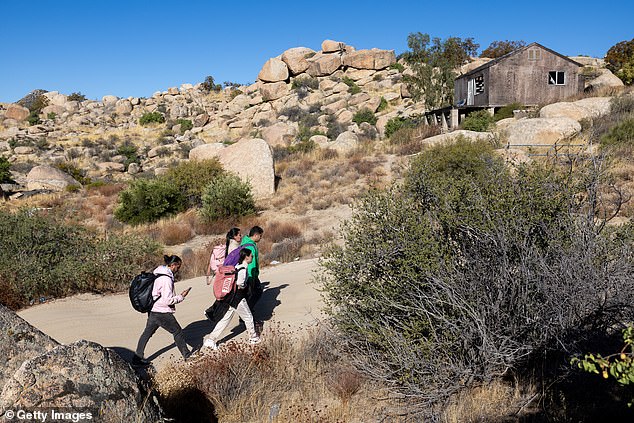Research shows that immigrants are twice as likely to develop serious mental disorders
Immigrants may be at greater risk of developing serious mental disorders, a major study suggests.
Using data from five countries, researchers looked at the medical records of nearly a thousand people who migrated to another country and compared them to natural citizens of the same age.
The team found that migrants who moved as children or teenagers are twice as likely to develop psychosis, a mental condition that causes sufferers to lose touch with reality.
The researchers believe that these detrimental mental health effects may be due to the trauma of migration occurring during crucial times of social development.
A new study has found that immigrants are up to 16 times more likely to suffer from psychosis than non-migrants (Photo: A group of people walking along the US-Mexico border in 2023)

The investigation comes at a time when immigration has become a major political talking point, including former President Donald Trump (pictured here) claiming that Haitian immigrants in Ohio are “eating” residents’ pets
The findings come amid a wave of migrants entering the US, largely from Central American countries such as Mexico, El Salvador and Guatemala, which has become a major political talking point ahead of next month’s presidential elections.
In a presidential debate last month, former President Donald Trump went so far as to say that Haitian immigrants in Springfield, Ohio, were “eating” residents’ pets.
Psychosis, which affects about 100,000 Americans, leads to hallucinations, delusions and extreme mood swings.
Between 2010 and 2015, the researchers, from five countries, recruited 937 migrants and 1,195 non-migrants.
Participants were born in European countries such as France, Great Britain, Italy and Spain, as well as in other regions such as North and Sub-Saharan Africa, the Middle East and the Americas.
The majority of migrants moved as adults, and nine in ten had no family history of psychosis.
The team “found that migration at any age was associated with a greater likelihood of psychosis” and “the largest increase was evident among those who migrated during adolescence.”
Overall, immigrants ages 11 to 17 had the highest risk of psychosis among all races.
White teenage immigrants were twice as likely to develop psychosis as their white non-migrant peers, while Asian teenagers were 29 percent more likely than non-migrants.
North African migrants were at the highest risk of psychosis, with an average three times greater risk among all age groups.
Teenagers in this group were the most vulnerable. The researchers found that North African teenagers aged 11 to 17 were 16 times as likely to have at least one psychotic episode than non-migrants, and that every other age group in that demographic group was at least three times as likely to have an episode .

The researchers noted that teenagers in particular may be susceptible to psychosis due to increased exposure to traumatic events and losing friends and other social networks (photo: Colombian asylum seekers walk through the desert after crossing the US and Mexico near Jacumba Hot Springs , California)
An important caveat, however, is that North Africans only made up less than four percent of the participants, which could lead to bias.
Black immigrants were also particularly susceptible to these mental health impacts, with black teens more than six times more likely to experience psychosis. Babies, meanwhile, had three times the risk, and adults in this group had twice the risk.
Although adults overall were 61 percent more likely to have psychosis than non-migrants, they had the lowest risk of all age groups.
The researchers noted that teens are particularly susceptible to psychosis due to several factors. For example, adolescent migrants, they said, were more likely to experience trauma such as separation from their parents than adults.
And teenagers are more likely than younger children to have experienced traumatic events such as violence and poor socio-economic status for longer periods of time.
Teenagers may also have more difficulty than young children adapting to their new culture, such as learning the language or making friends. Furthermore, the team noted that this group relies mainly on friends and social networks, and that migration would disrupt them.
In terms of race, Latino and Black populations are at the greatest risk for psychosis and other mental health disorders due to the greater likelihood of trauma such as racial discrimination, food insecurity, and police violence.
